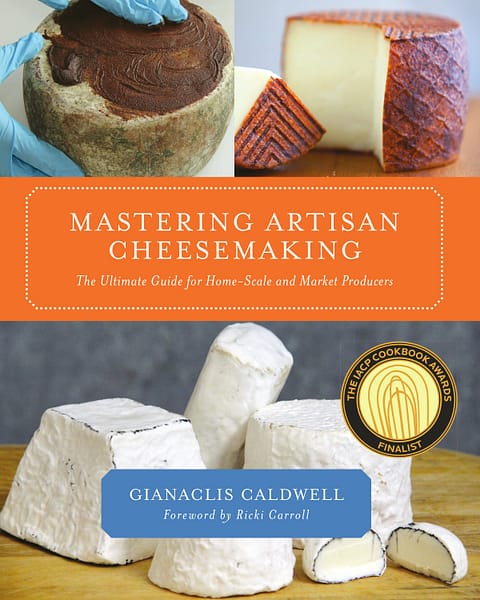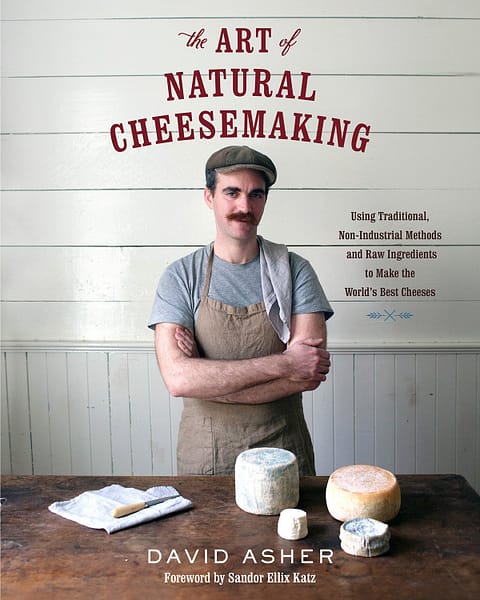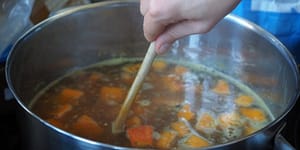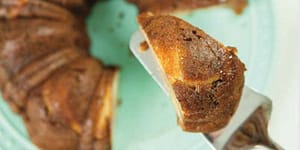Tracing the History of Cheddar with Cheesemonger Gordon Edgar

Cheddar is the world’s most ubiquitous and beloved cheese. You can find it nearly everywhere from macaroni and mousetraps to McDonald’s and mansions. Any cheese with so many fans has a story to tell, and Gordon Edgar is just the cheesemonger to tell it.
In his book, Cheddar, Edgar traces the unexplored history of America’s most iconic cheese. Traveling across the country to conduct his research, he delves into all corners of the cheese industry, researching everything from artisan wedges to mass-produced blocks and in the process reveals what this familiar food can tell us about ourselves and our culture.
We sat down with Gordon Edgar to learn about his journey and cheddar’s fascinating history, and hope you enjoy the Q&A below.
For more from Edgar listen to his interview on Vermont Public Radio.
A Conversation with Gordon Edgar
Chelsea Green: OK, let’s dispense with the suspense and cut to the chase: What state has the best, or perhaps most distinctive, cheddar in the US?*
Gordon Edgar: Trying to get me in trouble right off the bat … thanks! I do think Vermont has the most regionally-distinctive style. Vermont cheddars can be so intensely bitter and minerally that they define what the word “sharp” means to folks who grow up in the Northeast. But there are great cheddars in almost every cheese-producing state. Wisconsin, New York, California, Iowa … they can all be proud.
Editor’s note: An acceptable response. Please proceed.

GE: Defining “cheddar” is much harder than it sounds. Some would argue it has to be made around the region of Cheddar Gorge, England. Others refer to parts of the process: Are the curds “cheddared” (stacked on top of each other to release more moisture)? Are the curds milled? Is it clothbound or plastic-wrapped?
The trajectory of cheddar – similar to the trajectory of most food produced in the United States – is one of efficiency. A clothbound cheddar is amazing, but flawed, since it loses weight during the aging process. Every bit of moisture loss can be seen – in a society that prioritizes profit – as money lost. The attempt to transform milk as efficiently as possible to food meant that technological advances prioritized this and not flavor, tradition, or who could produce this cheese. Velveeta is not cheddar, but this “Pasteurized prepared cheese product,” came out of this trajectory — put in motion by the Williams cheddar factory of 1851 – that led to processed cheese. One of the fascinating things I came across in researching this book were old recipes for processed cheese which called for aged cheddars to be mixed with young cheddars (and emulsifiers) so that the processed cheese would have some familiar flavor.
But the real definition for cheddar? In the US it is defined by these technical factors: the minimum milkfat content is 50 percent by weight of the solids, and the maximum moisture content is 39 percent by weight. Not very romantic, is it?
CG: What are some of the common mistruths and misunderstanding about cheddar that you, an experienced cheesemonger, had to unlearn as you embarked on research for this book?
GE: I have a list:
- “Cheddar is the most popular cheese in the land.” False, though true for a long time.
- “England invented it and America cheapened it.” Kind of true, but not totally.
- “Certainly America never exported it, except maybe recently to Asia.” False. Totally and completely false.
- “Today’s 40-pound block was a precursor of Velveeta.” False.
- “Traditional clothbound cheddar went extinct in America.” True, but more complicated than I thought.
- “Vermont cheddar and Wisconsin cheddar are very different.” True, but more out of tradition than necessity.
- “’Cheddaring’ defines cheddar. Always has, always will.” False.
- “The cheddar factory built in New York in 1851 was the country’s first cheese factory.” Controversial and depends on the definition of “factory.”
- “There would be controversies about what could be called ‘true cheddar.’” True, but duh.
- “Cheddar will tell us something about our food system.” Well, geez, I hope so since I decided to spend a couple of years figuring out what it has to say.
CG: Cheddar has been allegedly eclipsed by another cheese in recent years as the most consumed cheese in the US. What is that cheese, and why is it now number one? And, what can each of us do in order to put cheddar back on top?
GE: Though it was Number One for about 150 years, mozzarella recently took the crown away from cheddar. If you question that, go take a look in your grocer’s freezer section and check out the frozen pizzas.

GE: The factory production model of cheddar was pioneered by the Williams family of Rome, New York, in 1851. Of course a “factory” in 1851 is very different from a factory in 2016, but the idea was that by bringing all the milk to a central location to be made into cheese, the farmer could be freed to farm and the cheesemaker could develop a better food. In a historical development that parallels the way that other foods and artisan products became industrialized, the factory model took off. This led — generally speaking, over the course of 150 years — to the priority of the cheesemaker becoming efficiency over distinct flavor.
Factory production of cheddar also took cheesemaking from being a woman’s job, one of many that the farmer’s wife had to perform, to being a male one. It wasn’t until the cheese renaissance of the 1970s and 80s (which we are reaping the fruits of today) that women returned to the make room.
CG: How does today’s American cheddar differ from cheddars made today in England, or even early American cheddars?
GE: Cheddar was once a wheel with a semi-porous rind that was made on a farm from the milk of the farmer’s cows. Nowadays, most cheddar made anywhere, not just in the US or UK, is made in 40- or 640-pound plastic-sealed blocks in factories that bring in milk from their regional farms. Some cheddar is still made the original farmstead way, and the biggest difference between that and cheddar from 150 years ago is in the development of consistent cheese cultures and understanding of food safety. Put simply, even very “traditional” cheesemakers today have a better understanding of how what they do affects what will happen to the cheese.
CG: You make note in the book that two of the best-known block cheddar makers — Cabot and Tillamook – are agricultural cooperatives. Is this a coincidence, or is there something about this model that allows them to keep a certain heritage alive and well?
GE: I think it’s clear that the cooperative model has allowed relatively smaller farms, from specific regional areas, to survive in a way they probably would not have if they were not organized as cooperatives. Both co-ops marketed their cheese as high quality and regionally distinct, and managed to survive through the eras when the cheese market became dominated by large, nation-wide corporations.
CG: Now that you’ve answered these questions, we have one more. With the new Star Wars film soon to be released, can you explain the role Wookey Hole plays in the evolution of cheddar? And, as a reminder, kids may be reading.
GE: I think you have to read the book for this story! Suffice it to say that Wookey Hole is a town in England’s West Country where this cave-aged brand of cheddar is made.
* Note to readers – Chelsea Green Publishing, the publisher of Cheddar is based in Vermont. So, the only correct answer to the first question is Vermont. No pressure, Gordon.
Recent Articles
Want to spice things up for this year’s holiday feast? We’ve got you covered! From delectable pork tenderloin to Spicebush Goose, these recipes will surely delight everyone at your Thanksgiving dinner table, even those passionate turkey traditionalists. These recipes have been adapted for the web. Roast Pork Tenderloin and Plum Sauce from The Healthy…
Read MoreSoup season is finally here! While the weather is getting colder, stocks and broths warm our bellies and fill our souls. Get started on your own classic stock this winter with help from this culinary insight and advice! The following is an excerpt from Mastering Stocks and Broths by Rachael Mamane. It has been adapted for the…
Read MoreNothing says “fall” quite like a homemade cake or pie! Add a little twist to your apple or pumpkin-flavored seasonal desserts that will have your guests begging for more. Not only are these treats delicious, but they’re healthy as well. The following is an excerpt from The Grain-Free, Sugar-Free, Dairy-Free Family Cookbook by Leah Webb.…
Read MoreScare hunger away with funky apple slice monsters! These easy-to-make snacks are perfect for kids (and kids at heart!) this Halloween and can even add a healthy ‘boo’-st to your blood sugar. The following is an excerpt from The Grain-Free, Sugar-Free, Dairy-Free Family Cookbook by Leah Webb. It has been adapted for the web. RECIPE: Funky Apple Slice…
Read MoreLearn how to grow shiitake mushrooms in almost any environment, including your yard and even your garage!
Read More







